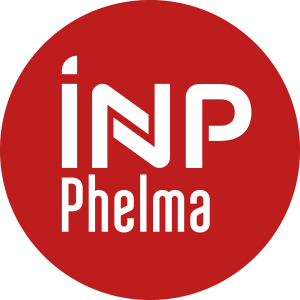Number of hours
- Lectures 14.0
- Projects 0
- Tutorials 8.0
- Internship 0
- Laboratory works 8.0
ECTS
ECTS 2.0
Goal(s)
The main objective is to give the basic principle of digital transmission, consisting in sending digital information into physical (analog) channel, ans see current basic techniques. I uses Information Theory results (C. Shannon) to give and interpret achievable performance and position the performance of basic modulations techniques (especially in terms of spectral efficiency and energy efficiency trade-offs). Other objective is to briefly present gives also a brief introduction of present radio-frequency transmission systems (e.g. : Mobile communication).
Contact Laurent ROSContent(s)
1. Base-band digital transmission
- line code : M-ary modulation with orthogonal Dictionnaries, Linear Modulations (Pulse-amplitude Modulations), general properties (power, power spectrum density, euclidian distance, energy and spectral efficiencies)
- Performance over AWGN channel case: Matched filter (Correlator), Nyquist criteria (Free Inter-Symbol-Interference criterion)
2. Carrier frequency digital transmission :
-Digital modulation : I/Q modulation-demodulation, linear (phase, amplitude, quadrature-amplitude) modulations,
-Coherent reception (AWGN case): detection theory, performances (bit error rate, spectral efficiency, distance from information theory),
3. Radio transmission systems :
General information about transmission systems (microwave links, satellite links, and radio-mobile communications, introduction to advances transmissions techniques such as CDMA (used in UMTS, ...) and OFDM (used in DVB, TNT, ...).
Part 1 will be treated in depth, while Parts 2 and 3 will be seen only briefly as extensions.
The course will be illustrated by classic Classworks as well as by Labworks sessions. The latter will consist of a guided mini-project consisting of developing a digital communication simulation chain and interpreting the results directly linked to the course. This will will result in the redaction of a report which will be noted (1/3 of the overall mark).
Prerequisites
- Basic of Deterministic signal Processing (Analog and Digital)
- Basic of Random Signal Processing (Stationry stochastic process, Correlation and Spectrum, White Gaussian Noise)
1 Written exam (2 h) (E).
1 report after Labworks (C)
Session 1 : N1=E1x0.65 + Cx0.35 si cours et examens en présence possibles,
sinon N1 = 100% contrôle continu (E1 et C devenant des rapports à rendre)
Session 2 : N2=E2x0.65 + Cx0.35 si examen E2 présentiel possible, sinon E2 est remplacé par une examen à distance
J. Proakis and M. Salehi. Digital Communications. McGraw-Hill, 2008 (fifth edition).
S. Haykin. “Digital Communications”. Wiley, 1988 (and more recent editions, up to 2013)Glavieux, M. Joindot. Communications numériques, introduction. Collection pédagogique des télécommunications, Masson, 1996.



